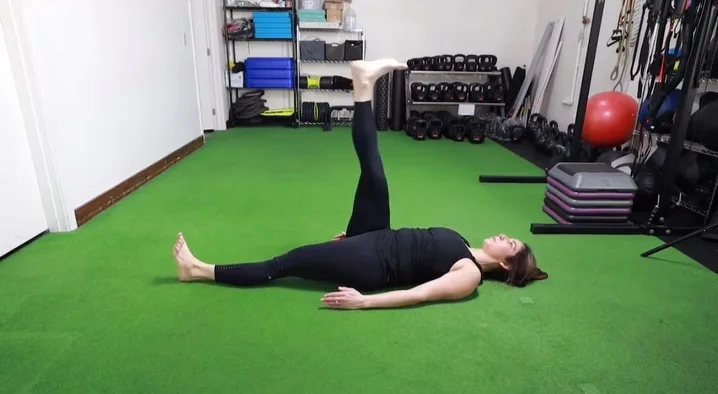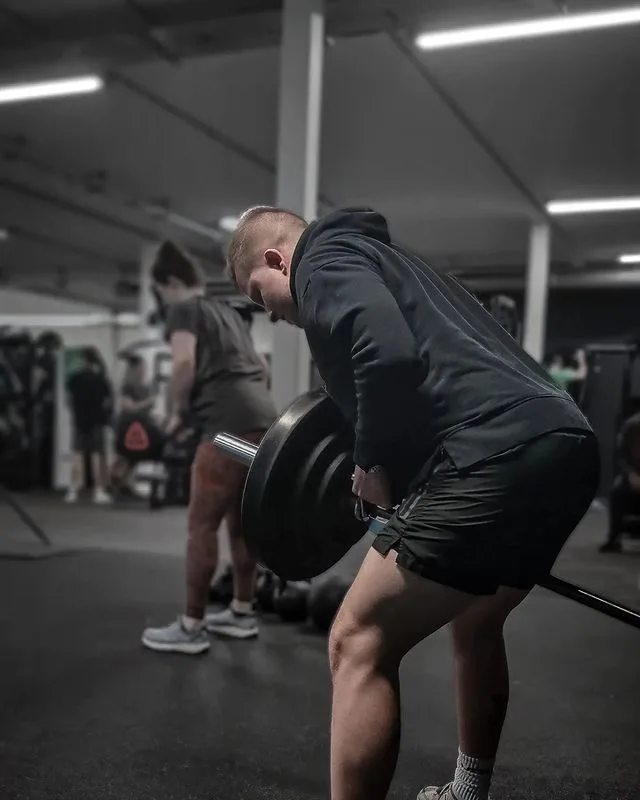Supine leg switching, also known as supine leg cycling or supine leg kicks, improve lower body strength, flexibility, and cardiovascular endurance. It also activates the core muscles and can be used in rehabilitation programs for certain injuries or conditions affecting the lower body.
It involves performing cycling-like movements with your legs while lying on your back (in the supine position). This exercise is typically done on a mat or a flat surface.
Benefits of Supine Leg Switching
Supine leg switching offers a range of physical and mental benefits, which are the giving below:
Physical Benefits:
- Lower Body Strength: The cycling-like motion engages the muscles in your legs, including your quadriceps, hamstrings, calves, and glutes. Regular practice can help strengthen and tone these muscles.
- Cardiovascular Endurance: Supine leg switching is a low-impact aerobic exercise that gets your heart rate up. Consistent practice can contribute to improved cardiovascular fitness and endurance.
- Flexibility and Range of Motion: The leg cycling motion involves bending and extending the hip and knee joints, promoting flexibility and improving the range of motion in your lower body.
- Core Activation: Engaging your core muscles to stabilize your torso during the exercise helps strengthen your abdominal muscles and improve overall core stability.
- Rehabilitation and Injury Prevention: Supine leg switching can be incorporated into rehabilitation programs for lower body injuries or conditions. The controlled movement helps maintain muscle strength and flexibility, promoting recovery and reducing the risk of future injuries.
Mental Benefits:
- Stress Relief: Engaging in physical activity, including supine leg switching, releases endorphins, which are known as “feel-good” hormones. This can help reduce stress levels and improve your mood.
- Mind-Body Connection: Focusing on the controlled movement and coordinating your leg switches can enhance the mind-body connection. This mindfulness aspect can promote relaxation and a sense of body awareness.
- Improved Concentration: Performing supine leg switching requires concentration and focus on the movement. Regular practice can improve your ability to stay present and focused, potentially enhancing your overall concentration skills.
- Mental Refreshment: Engaging in physical exercise can provide a break from daily routines and help clear your mind. Supine leg switching can offer a refreshing and energizing experience.
Step-by-step Supine Leg Switching (Supine Leg Cycling)


- Lie down on a mat or a flat surface with your back resting against the ground. Make sure you have enough space around you to extend your legs fully.
- Position your legs straight out in front of you, keeping them close together. Place your arms comfortably by your sides, palms facing down.
- Engage your core muscles by gently drawing your navel toward your spine. This will help stabilize your torso during the exercise.
- Lift one leg slightly off the ground, ensuring it remains straight throughout the movement. Keep the other leg extended on the ground.
- Begin the cycling motion with the lifted leg, as if you were pedaling a bicycle. Start by flexing your hip joint and bringing your knee towards your chest. Then, extend your leg forward, straightening it completely.
- While one leg is cycling, slowly lower the other leg back down to the ground, keeping it straight.
- Continue the cycling motion with the lifted leg, maintaining a controlled and fluid movement. Aim for a smooth and continuous motion without any jerking or bouncing.
- After a few cycles with one leg, switch to the other leg. Lift the leg that was on the ground, while lowering the leg that was cycling. The legs should switch positions, mimicking the motion of pedaling a bicycle.
- Repeat the leg switching motion, alternating between legs in a rhythmic manner.
- Depending on your fitness level and goals, continue the exercise for the required length or number of repetitions. Starting with a few repetitions and progressively increasing the time and intensity as you develop is suggested.
Common Mistakes
While performing Supine Leg Switching, certain common mistakes can occur, which may affect the effectiveness of the exercise or increase the risk of injury. However, the common mistakes of the Supine Leg Cycling are explaining below:
1. Jerky or Uncontrolled Movements
Rapid or jerky leg movements can compromise the exercise’s effectiveness. When the movements lack control, you may not fully engage the targeted muscles, reducing the potential benefits. Additionally, sudden, uncontrolled movements increase the risk of straining or injuring your muscles or joints. It’s essential to maintain a smooth and controlled motion throughout the exercise.
2. Lifting the Head and Shoulders
Raising your head and shoulders off the ground during supine leg switching can strain your neck and upper back muscles. It shifts the focus away from the lower body and core engagement. Keep your head and shoulders relaxed on the ground, ensuring that the movement originates from your legs and core, rather than from your upper body.
3. Holding the Breath
Holding your breath or shallow breathing can limit oxygen intake and impede your overall performance. It’s important to breathe naturally throughout the exercise, inhaling and exhaling in a relaxed manner. Proper breathing supports oxygenation of the muscles, enhances endurance, and helps you maintain a steady rhythm during the leg switching motion.
4. Arching the Lower Back
Allowing your lower back to arch excessively or lifting it off the ground can strain the lumbar spine and compromise the core engagement. It’s crucial to maintain a neutral spine position, gently pressing your lower back into the ground. This posture supports proper muscle activation and protects your lower back during the exercise.
5. Overextending or Locking the Knees
Hyperextending or locking your knees at full extension can place unnecessary stress on the joint and hinder muscle engagement. Instead, keep a slight bend in your knees throughout the exercise. This allows for better muscle activation, especially in the quadriceps and hamstrings, and helps maintain joint integrity.
6. Rushing Through the Exercise
Performing supine leg switching too quickly or without proper form diminishes its effectiveness. Rushing can lead to sloppy movements and reduced muscle engagement. Take your time and focus on the quality of each leg switch. Perform the exercise at a controlled pace, ensuring smooth transitions between leg movements.
Modifications and variations
Modifications and variations of exercises like supine leg switching can be beneficial to accommodate different fitness levels, target specific muscle groups, or add variety to your workout routine. Therefore, the modifications and variations of the exercise are explaining below:
- Modified Range of Motion: If you have limited flexibility or mobility, you can modify the range of motion during supine leg switching. Instead of fully extending your legs, focus on comfortable and controlled movements within your range. This modification allows you to engage the muscles and improve flexibility gradually without straining or overstretching.
- Resistance Band or Ankle Weights: To add resistance and intensify the exercise, you can incorporate a resistance band or ankle weights. Attach a resistance band around your feet or ankles, or wear ankle weights to increase the resistance as you cycle your legs. This variation challenges your muscles further, helping to build strength and increase the difficulty of the exercise.
- Single-Leg Supine Leg Switching: Instead of alternating between legs, you can perform the exercise with one leg at a time. Lift one leg off the ground and cycle it while the other leg remains extended. This variation allows you to focus on each leg individually, emphasizing muscle activation and control. It also provides an opportunity to address any strength imbalances between your legs.
- Flutter Kicks: Flutter kicks involve rapidly alternating leg movements, similar to the fluttering motion of a butterfly’s wings. Instead of the cyclical motion in supine leg switching, flutter kicks involve short and quick up-and-down movements of each leg independently. This variation targets the lower abs and hip flexors, providing a challenging workout for those specific muscles.
- Pilates Scissor Kick: The Pilates scissor kick is a variation that incorporates diagonal leg movements. Lift both legs off the ground, keeping them straight. Cross one leg over the other and then switch their positions in a scissoring motion. This variation engages the core muscles, inner thighs, and hip flexors while challenging your balance and coordination.
- Supine Bicycle Crunches: Combine supine leg switching with abdominal work by incorporating bicycle crunches. Lift your head and shoulders off the ground, bringing your opposite elbow towards the opposite knee as you cycle your legs. This variation targets the abs, obliques, and hip flexors, providing a comprehensive core workout.
Precautions and Contraindications of Supine Leg Switching
While supine leg switching is generally a safe exercise, it’s important to be aware of precautions and contraindications to ensure your safety and well-being. Therefore, It’s essential to prioritize safety and modify or avoid exercises that are not suitable for your specific circumstances.
- Existing Injuries or Conditions: If you have any existing injuries or medical conditions affecting your hips, knees, lower back, or abdominal muscles, it’s crucial to consult with a healthcare professional or a qualified fitness instructor before attempting supine leg switching. They can provide guidance on whether the exercise is suitable for you or recommend modifications to accommodate your specific needs.
- Lower Back Issues: Supine leg switching involves engaging the core muscles, including the lower back. If you have a history of lower back issues, such as herniated discs, spinal stenosis, or chronic lower back pain, it’s important to exercise caution and possibly modify the exercise to avoid exacerbating your condition. Focus on maintaining a neutral spine position and avoid excessive arching or strain on the lower back.
- Pregnancy: During pregnancy, the body undergoes significant changes, particularly in the abdominal and pelvic regions. Supine leg switching may not be suitable for pregnant women, especially during the later stages of pregnancy, as it places pressure on the abdomen and pelvic floor. It’s crucial to consult with a healthcare professional for guidance on safe exercises during pregnancy.
- Recent Surgeries: If you have recently undergone surgery, particularly in the abdominal, hip, or knee areas, it’s important to follow your surgeon’s post-operative guidelines and restrictions. They may recommend avoiding or modifying exercises like supine leg switching until you have fully healed and received clearance to engage in physical activity.
- Pain or Discomfort: If you experience pain or discomfort during supine leg switching, it’s crucial to listen to your body and stop the exercise. Pain may indicate an underlying issue or improper form. Adjust your positioning, range of motion, or seek guidance from a fitness professional to ensure proper technique and prevent injury.














